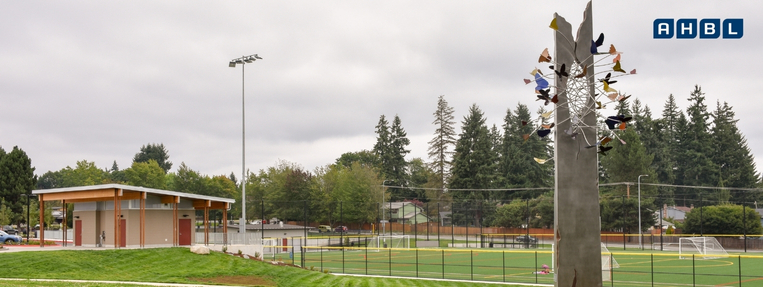Fostering Community by Including Art in Our Parks
Author: Nicole Milburn
Contributor: Craig Skipton, PLA, LEED AP
Studies have shown that incorporating art within public parks creates a meaningful, relevant space that is more personal to park users, connecting them with the broader community and drawing in new park users. In addition to adding visual interest and beautification of spaces, public artworks promote stewardship and can spark conversations around cultural heritage, history, and urban and environmental issues.
Today, many cities throughout the country and in the Pacific Northwest have a 1% for Art program for City projects above a certain threshold. Even at a time when public budgets are stretched thin, coordinated public participation has proven successful in garnering increased voter support for public art programs and investments. Every location is unique and has a story to tell, and the art within our parks adds meaning and attachment to these spaces and to the greater community. Recognizing the value public art provides, AHBL is committed to helping municipalities discover and build support for opportunities to include public art in projects. Through innovative planning, design, and engineering, we improve our communities and build collaborative partnerships one project at a time. AHBL takes the time to explore local artists to add to our project team to ensure authenticity and ensure our designs resonate with the local community.
132nd Square Park, Kirkland, WA
The Kirkland Cultural Arts Commission (KCAC), along with community members with a love for preservation and advocacy, encouraged the City to enhance and improve 132nd Square Park with multiple public art installations. One unique art feature, created by Rainworks, can only be seen when it rains, encouraging park users to follow the stream of fish that swim towards the message “Lake Washington Starts Here – Don’t Pollute, Protect Our Fish,” reminding us that our storm and surface water drains to Lake Washington, and we can all play a part in reducing pollution. This innovative approach engages park users, both young and old, in an enchanting way.
Additional sculptural elements located in the park honor the Duwamish Tribe as the original inhabitants of the land that is present day Kirkland. Designed by Cobalt Designworks, the artwork conveys the strengths and uniqueness of the individual and the power we possess when we come together. The first element is a large, unfurled cocoon, cradled by a bunch of grassy reeds denoting the ever-evolving nature of our individual selves. The second is a 20-foot-tall tree-like structure that includes a raven feather and bald eagle feather, along with dozens of butterflies bursting out in a vibrant rainbow of color, symbolizing the beauty of coming together in our diversity and uniqueness. The carefully chosen butterflies represent Kirkland’s large immigrant populations as well as those native to the US and the Pacific Northwest. There are six species of butterflies represented, each with its own size, shape, color, and origin. AHBL provided structural engineering for the pillar and cocoon footings supporting the two “Individually We Transform, Together We Soar” art installations.
Olympia Urban Farm Park, Olympia, WA
The Local Food movement is strong in Olympia and the Thurston County area. The idea of developing an urban farm park, a place to grow food, grow and support local farmers with the skills and knowledge needed to encourage and cultivate a diverse agricultural community of urban farmers and gardeners, grew out of the desire to find ways to support the growth and continuation of access to local food and growing future farmers. The envisioned Urban Farm Park would provide space to grow foods of all kinds, including culturally significant foods, give access to shared equipment and storage space, and provide opportunities for recreation and stewardship.
The AHBL team, which includes ECONorthwest, Olympia-based artist Carrie Ziegler, and Adam Peterson with the Thurston Conservation District, completed stakeholder interviews, led a discovery workshop with local organizations involved in area agriculture and community members, and explored several types of existing community-based agriculture examples to identify similarities and opportunities for Olympia’s Urban Farm Park. As the study moved forward, additional deliverables included identifying potential partnerships and resources, and facilitating diverse community engagement to identify key characteristics of the urban farm park.
The team co-hosted a visioning art workshop with residents and organization representatives interested in this topic. Facilitating the workshop was local Olympia artist Carrie Ziegler, who believes in using art to create change in communities. The combined engagement approach resulted in a trove of ideas, including the desire to include art in the park.
AHBL looks forward to bringing the vision to life!
